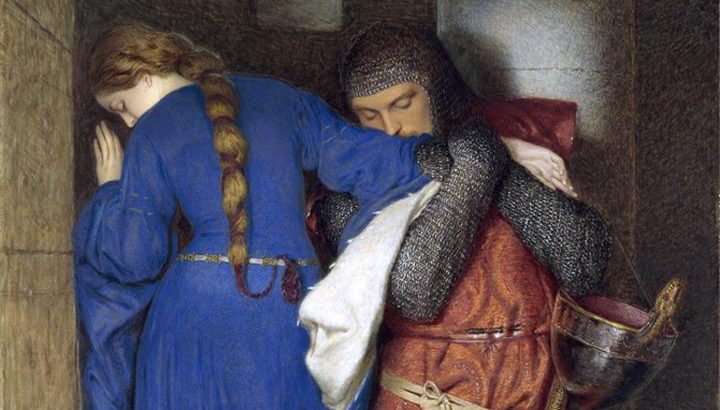Frederic William Burton: For the Love of Art
Exhibition curated by Marie Bourke, with essays by Patrick Duffy and others, edited by Claire Crowley (National Gallery of Ireland, €15.95)
Thanks to RTÉ we know that ‘The Meeting on the Turret Stairs’ is Ireland’s favourite painting. Yet experience tells us, too, that many who admire it are unclear about what it shows – an illicit love blighted – or about the great achievements of its creator, William Frederick Burton, born two centuries ago. Now thanks to a once in a lifetime exhibition at the National Gallery, the first since soon after his death in 1900, many admirers of the painting will be enlightened.
Intimate
The picture is in fact not as large as many people imagine. It is a relatively small water colour. As Burton worked largely in that medium most of the paintings on display are on the small scale. They are this intimate and sensitive, especially the studies of women and children. But even an ancient stone altar on the Aran Islands is painted in close up in an intimate way. The grandiose did not appeal to him.
Starting as a painter Burton ended his life as the director of the National Gallery in London, an onerous post that left little time for painting. In his early years in Ireland he associated with people like Thomas Davis, Whitley Stokes and George Petrie, who are often seen as contributing to a new idea of what Ireland had been, was, and could be in the future.
Burton’s pictures of the west are indeed important anthropological and historical documents in their own right: the Aran fisherman at the wake for his drowned child looks straight out of the painting, as if asking: “Why do these things have to be?”
When he moved to London his work changed. But it was his travels through Europe especially Germany and the countries to the south that opened his eyes to new images. One of the pieces here, of an Albanian bandit testing the sharpness of his knife, summarises what was then thought about the romantic Balkans.
Marie Bourke, by showing Burton’s work alongside pictures he saw and places he visited, achieves a depth to his imaginary world which provides interesting contrast with his earlier work in the West of Ireland. Some of these such as The Last of the Brotherhood by Herman Dyck, which contrasts with Burton’s own small watercolour of people at a confessional in South Germany in an interesting way. Her curatorial taste is well matched by the scholarship of the accompanying catalogue.
But it is that sense of intimacy that leaves the greatest impression. The best things are the images of women and young children. Burton never married, but one of the finest things in the exhibition is a quietly moving portrait of the Irish lady he was betrothed to – in the painting she wears a large ring which was his gift to her. But she died before he spoke.
Technician
He was a marvellous technician. As a water-colourist he had very expert skills to achieve his affects. But with a pencil he was also effective, as his self portrait sketch as a young man shows.
Burton learnt a great deal from the Renaissance drawing he collected. One drawing of his own should not be overlooked though.
When the poet James Clarence Mangan died in 1849 Burton was summoned by the attending surgeon to his bedside, where he drew the late poet’s head. Though only a sketch, it is of miraculous delicacy, and one of the great icons of the European Romantic movement.
National Gallery of Ireland 25 October 2017 – 14 January 2018. Admission charge. Ticket Booking: www.nationalgallery.ie


 Peter Costello
Peter Costello Frederic William Burton (1816 - 1900), The Meeting on the Turret Stairs (1864)
Frederic William Burton (1816 - 1900), The Meeting on the Turret Stairs (1864) 